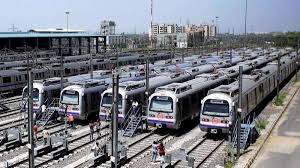The Delhi Metro Information is a rapid transit system that serves the National Capital Region (NCR) of India, primarily the city of Delhi. Established to ease the traffic congestion and reduce pollution, it is one of the largest and most efficient metro systems in India and the world. The Delhi Metro was conceived by the Delhi Metro Rail Corporation (DMRC), a government-owned entity formed in 1995.
The metro began operations in December 2002 with a modest 8.3 km stretch on the Red Line between Shahdara and Tis Hazari. Since then, the network has grown exponentially, making it a backbone of public transportation in Delhi.

Structure and Network
TThe major lines include:
- Red Line (Line 1): This was the first line and connects Rithala in the northwest to Shaheed Sthal (New Bus Adda) in Ghaziabad.
- Blue Line (Line 3/4): One of the busiest lines, the Blue Line connects Dwarka Sector 21 in the southwest to Noida City Centre/Vaishali in the east, with a branch extending to Noida.
- Yellow Line (Line 2): It runs from Samaypur Badli in the north to Huda City Centre in Gurgaon, covering major stations like Rajiv Chowk and Central Secretariat.
- Green Line (Line 5): The Green Line connects Brigadier Hoshiar Singh in Bahadurgarh with the Delhi Metro network.
- Violet Line (Line 6): Connecting Kashmere Gate to the Badarpur area in the southern part of Delhi.
- Magenta Line (Line 8): This line connects Janakpuri West to Botanical Garden, passing through key points like Terminal 1 and Kalindi Kunj.
- Pink Line (Line 7): Part of the phase 4 expansion, this line connects Majlis Park to Shiv Vihar.
Facilities and Accessibility
- Stations: The metro stations are designed to be accessible for all passengers, including those with disabilities. Many stations have elevators, escalators, and wheelchair ramps. Stations also feature high-tech amenities such as free Wi-Fi at key stations, catering services, and clean waiting areas.
- Safety Measures: The Delhi Metro maintains high standards of safety and cleanliness. Security is provided through CCTV surveillance, sniffer dogs, and metal detectors at all stations. Moreover, the metro has a Dedicated Disaster Management Team to handle emergencies. In addition to this, the Delhi Metro also features fire-safety systems and automatic train protection (ATP).
- Environmental Impact: One of the key advantages of the Delhi Metro is its contribution to reducing pollution and mitigating traffic congestion.
Expansion and Future Projects
Delhi Metro Information continues to expand rapidly to meet the ever-growing demand for public transportation. For example, new lines will link Dwarka to Najafgarh, Saket to Panchsheel Park, and Mukundpur to Majlis Park.
Challenges and Criticisms
Despite its success, the Delhi Metro Information faces a few challenges. The expansion of the network has resulted in disruptions in traffic, especially during the construction of new stations. Moreover, the metro system, although reliable, faces occasional overcrowding during peak hours, particularly on lines like the Yellow Line.
Additionally, Delhi’s climate — with extreme summers and the pollution problem — creates unique operational difficulties. Ensuring smooth operations during high heat and keeping the air clean in stations are ongoing concerns.
Conclusion
The Delhi Metro has become an integral part of daily life for millions of people in the National Capital Region.